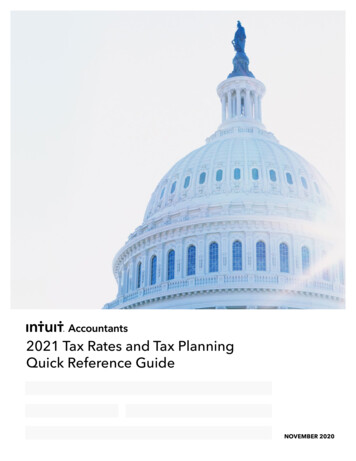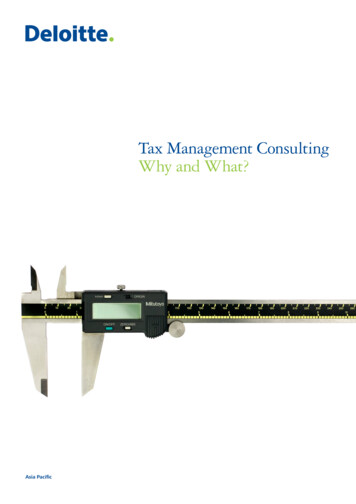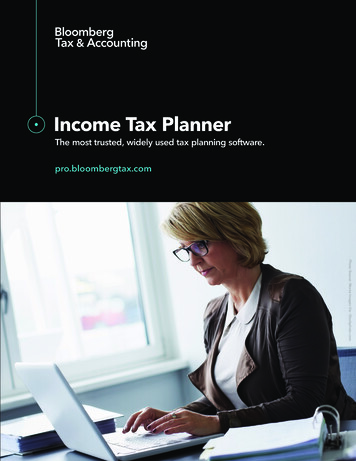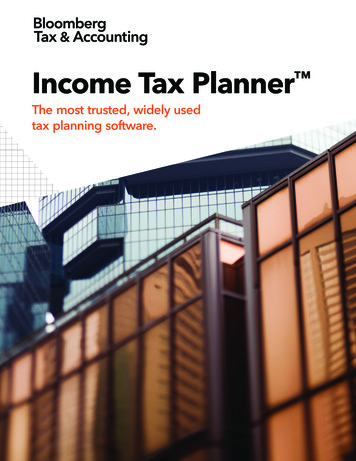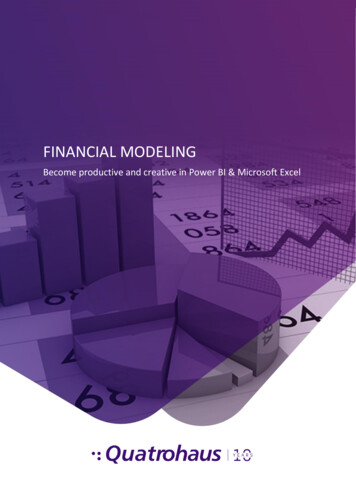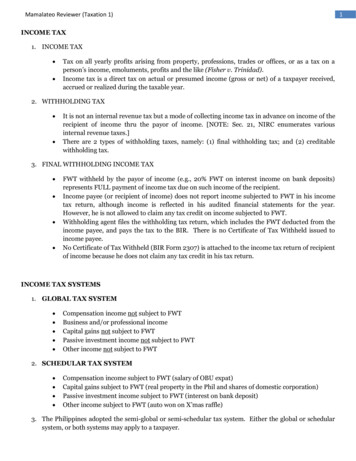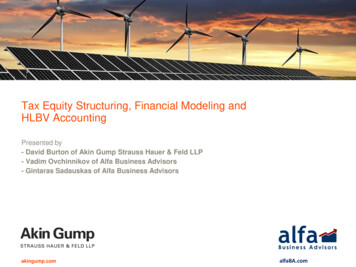
Transcription
Tax Equity Structuring, Financial Modeling andHLBV AccountingPresented by- David Burton of Akin Gump Strauss Hauer & Feld LLP- Vadim Ovchinnikov of Alfa Business Advisors- Gintaras Sadauskas of Alfa Business Advisorsakingump.comalfaBA.com
PTC Start of Construction Guidance –IRS Notice 2013-29 IRS Notice 2013-29 is generally favorable The Notice provides two methods to start construction in 2013: Commence physical work of a significant nature in 2013; or Incur at least 5% of the cost of the project in 2013 Both methods generally follow the Treasury Cash Grant guidance but with some key differences IRS Notice 2013-60 provided project need not be “continuously constructed” so longas it is completed by the end of 2015. IRS Notice 2014-46 confirmed that no minimum level of work was required to haveoccurred in 2013 in order to meet the “physical work of a significant nature”requirement; provided work of the appropriate nature was performed in 2013. It alsoprovided guidance on transfers from one taxpayer to another of projects that hadachieved start of construction in 2013.akingump.comalfaBA.com1
Wind Overview After-tax IRR of 7.5 to 9.5% unlevered for partnership deals Levered deals get up to a 200 bp premium, but they are rare "There is not as much tax equity investment as the industry canabsorb and there are not many new tax investors. This is whywe keep seeing the same names popping up.” – Power Finance& Risk, Vol. XVI, No. 31, Aug. 2013. 15 to 20 investors in the market. Each is very particular, so eachdeal only has a handful of candidates Eligible for 2.3 cent KwH production tax credit or 30%investment tax credit Also eligible for 5-year MACRS depreciation Production tax credit only available in partnership and directownership structures Investment tax credit is available in a partnership, saleleaseback or pass-through lease structure Deadline: must have "started construction" by the end of 2013and be done by the end of 2015 or else must "continuously"constructakingump.comalfaBA.com2
Solar Overview 30% investment tax credit for projects"placed in service" by the end of 2016.Projects after that are entitled to a 10%investment tax credit Five year MACRS on the basis reduced byhalf of the investment tax credit Wide range of after-tax return rates asmarket is immature Some say 11-12% after-tax IRR unlevered Investment tax credit is recaptured if atransfer or a change in partnershipallocations occur in the first five years Secured debt is rare as a foreclosure in thefirst five years would trigger recapture and atax bill for the tax equity investor “Back leverage” is more typicalakingump.comalfaBA.com3
3 Solar Markets: Utility Scale, Distributed Generation(Commercial Roofs) and Residential Utility scale is projects over 1 MW These projects are getting rare as utilities are reluctant to sign power purchaseagreements Utility scale is being dominated by balance sheet players, like MidAm and Exelon Distributed generation - 500 kw to 1 MW Municipal government buildings and big box stores are typical sites Tax equity investors are getting more and more comfortable in this space Residential - largest demand and fewest investors Great opportunity but many issues to get comfortable with (e.g., consumerprotection laws)akingump.comalfaBA.com4
Business Challenges of Project ParticipantsEach project participant is faced with a different set of challenges and solutions they bring to the table:Developers& Sponsors Equipmentand servicesSuppliers Limited resources (often limited tax appetite) Project development / portfolio growth Asset / operations management Compliance and reportingInvestors Project origination Asset portfolio management Often substantial taxappetiteProject Technical, legal,financial, tax andaccountingexpertiseAdvisorsLenders Project origination Loan portfolio managementOff-takers Regulatoryenvironment New capacity additions Power pricingakingump.comalfaBA.com5
Tax Equity Financing AlternativesRenewable energy project economics in the USheavily depend on tax incentives. As such, anumber of different financing structures haveevolved to help monetize tax incentives.TaxIncentivesTax EquityStructuresThe choice of a particular financing structuredepends on a number of factors / constraints: Project parameters (technology, size,economics) Investor / lender preferences Market conditions Regulatory environmentIt is very important to understand the impact oftax incentives on project economics andsponsor / tax equity investor returns.ConstraintsEconomicallyOptimal SolutionThe ultimate objective is to allocate tax benefits to a party that can use them most efficiently.akingump.comalfaBA.com6
Partnership Flipakingump.comalfaBA.com7
Partnership Flip Structure – Rev. Proc. 2007-65InvestorDeveloper99% /Energy 5%OfftakerEnergyPayments1% /95%Project Co. Project typically is financed with some combination of Developer equity and Investor equity and, insome cases, debt Investor acquires interest in project company for cash Investor typically makes an up-front investment, although Investor also may make pay-as-you-gopayments (i.e., PAYGO) Investor initially is allocated as much as 99% of tax items (PTC or ITC and depreciation) andsubsequently “flips” down to 5% after achieving a specified after-tax IRR Cash may be distributed in the same manner that tax items are allocated, or Developer may have acash preference for some period to recover development costs Developer generally has purchase option after flip point Option may not be exercised until 5 years after property is placed in serviceakingump.comalfaBA.com8
Partnership Flip Structure (cont’d) Advantages Flexible structure that allows efficient monetization of as much as 99% of taxbenefits IRS safe harbor in context of wind projects (Rev. Proc. 2007-65) Widely used and accepted structure Developer’s purchase option is less costly Can be used for PTC & ITC Basis reduced by only 50% of ITC Disadvantages Developer must have at least a 1% interest in tax items In case of ITC, Investor must be in partnership before placed-in-service date Indirect ownership by any tax-exempt or governmental entities may precludeeligibility for grant Complicated partnership tax rules and financial accountingakingump.comalfaBA.com9
Unlevered Partnership Flip StructureTypical AllocationsPre-Flip PeriodTaxInvestorCash0%Sponsor100% (1)TaxInvestorSponsor5%95%1%5%95%1%5%95%100% (2)0%Tax Credits99%Taxable Income /Loss99%(1)(2)Post-Flip PeriodUntil the earlier of the initial capital contribution recovery or a date certain.From the date in (1) through the Flip Date (typically Year 10).Key considerations: Tax equity sizing Tax equity target IRR, flip dates Compliance with partnership taxation rules (704(b) capital accounts, tax basis). Debt RestorationObligation (“DRO”) provisions. Possible re-allocation of tax benefits back to sponsor can lead to taxinefficiencies. Choice of financial accounting method, e.g. HLBV method. Hypothetical liquidation and tax makewhole provisions (tax implications of liquidation must be considered) in HLBV.akingump.comalfaBA.com10
Modeling 704(b) Capital Accounts and Tax BasisThis is one of the most complex areas of partnershiptaxation.To assess the economic impact of a given tax equitypartnership structure, a clear understanding of the 704(b)capital accounts and tax basis logic is required.Financial models should have monthly 704(b) capitalaccounts and tax bases for each partner from financialclose through project end that incorporate the followingkey components: Contributions / distributions Taxable income / (loss) Remedial depreciation – 704(c) Minimum gain Stop loss reallocation Excess distributions Deficit Restoration Obligation (“DRO”) Suspended losses Tools for easy updates for actuals and tie-out tofiled tax returns.akingump.comKey Parameters of UnleveredPartnership Flip Structure:- cash and tax benefit sharing ratios- target returns and flip datesTax Logic:- 704(b) capital accounts- tax basisAccounting Logic (HLBV):- partnership liquidation provisions- HLBV waterfallalfaBA.com11
Modeling Example - 704(b) Capital Accounts§704(b) CAPITAL ACCOUNTSSponsor 704(b) Capital AccountOpening balanceContributionsPlus tax incomeMinus tax lossesRemedial depreciationMinus cash distribution754 Step-UpInterim balanceStop loss reallocation from investor to sponsorStop loss reallocation from sponsor to investorMin gain adjustmentsClosing )879,186(696,454)182,732Investor 704(b) Capital AccountOpening balanceContributionsPlus tax incomeMinus tax lossesRemedial depreciationMinus cash distribution754 Step-UpInterim balanceStop loss reallocation from investor to sponsorStop loss reallocation from sponsor to investorMin gain adjustmentsClosing ump.comalfaBA.com12
Modeling Example – Tax BasisTAX BASISSponsor tax basisOpening balanceContributionsPlus taxable incomeMinus Cash distributionInterim balanceExcess DistributionMinus Taxable lossStop loss reallocation incl. min gain adj.Suspended LossClosing ,339Investor tax basisOpening balanceContributionsPlus taxable incomeMinus Cash distributionInterim balanceExcess DistributionMinus Taxable lossStop loss reallocation incl. min gain adj.Suspended LossClosing 59696,4544,310,413akingump.comalfaBA.com13
Modeling 704(b) Capital Accounts and Tax Basis Think of 704(b) capital accounts and tax basis as “tax accounting statements” - every partnershiphas them. 704(b) capital account starts at the sum of the cash and property (at FMV) that the partnercontributes to the partnership. Tax basis starts with the sum of the cash and basis of property(generally, at cost) that the partner contributes to the partnership. (If the partnership hasnonrecourse debt, then the partner’s share of this debt is added to his tax basis.) Both 704(b) capital account and tax basis go up (by income allocated to the partner) and down(by cash distributed or losses allocated to the partner) during the life of the partnership. 704(b) capital account is its claim on partnership assets at liquidation. Tax basis will determinehow much gain a partner has if it sells its partnership interest. Both 704(b) capital account and tax basis restrict the amount of losses that the partnership mayallocate to a partner to the equity that the partner has contributed to the partnership. Typically,ending balances cannot go below zero. Stop Loss Reallocations. In the event 704(b) capital account balance shows a deficit in excess ofany deficit restoration obligation and allocable non-recourse debt, that loss would be‘‘reallocated’’ to the other partner. The reallocated losses are also taken into account indetermining each partner’s share of taxable income, which flows through the calculation of thepartners’ tax bases.akingump.comalfaBA.com14
Modeling 704(b) Capital Accounts and Tax Basis Excess Distribution. Whenever a partner receives a distribution that would exceed its tax basis,the partners’ 704(b) capital accounts are increased. DRO. One way of dealing with a negative balance in 704(b) capital account is for the partners toagree to a ‘‘deficit restoration obligation,’’ or DRO. A partner that agrees to a DRO will have tocontribute cash to the partnership, if it has a negative capital account when the partnershipliquidates. This is because a partner that dips below the line essentially ‘‘borrows’’ equity fromthe other partner. A DRO is a real obligation, but it will not require the partner to post any collateral. Other than thecase of a partnership that has borrowed non-recourse debt, the capital account deficit representsthe amount of cash that the partner would be obligated to contribute to the partnership uponliquidation. An investor typically caps the DRO it is willing to step into at a fixed dollar amount,generally no greater than 10 percent to 20 percent of its total investment, although someinvestors refuse to agree to any DRO. Suspended Losses. No allocation of losses will drag the partner’s tax basis below zero. Unlikefor 704(b) capital accounts, these excess losses are not reallocated to the other partner. Theyare merely suspended to be claimed in a later period when the partner’s outside basis is positive.akingump.comalfaBA.com15
Hypothetical Liquidation at Book Value (HLBV) The HBLV (Hypothetical Liquidation at Book Value) is an income or loss allocation method for USGAAP purposes. HLBV is frequently used in Variable Interest Entities (“VIEs”) where cash andtax benefit sharing ratios between partners change over the life of a project. The method determines how better or worse off the partners are at the end of the period thanthey were at the beginning of the period in a tax equity structure assuming hypothetical liquidationof a project at book value To determine the periodic income/loss allocation, one must follow the steps: Assume liquidation of project assets at book value per liquidation provisions in thepartnership agreement Determine how much of the liquidation proceeds to allocate to each partner Calculate the change in the allocated liquidation proceeds to each partner during theperiod and record as book income/loss (adjusted for distributions and contributions) Typical liquidation waterfall has the following four steps: Allocation of the hypothetical gain to eliminate deficit balances in capital accounts ofClass A and Class B members; Class B (sponsor) return of capital; Class A (tax equity investor) target IRR (including tax credits and other tax benefits); Back-end sharing of remaining liquidation proceeds at pre-agreed ratios.The HLBV method produces non-linear GAAP income allocation resultsakingump.comalfaBA.com16
HLBV Numerical Example6/30/20147/31/2014368,679(93,369)Project Adjusted Net Book Value125,855,117124,974,211Gain upon Liquidation109,091,867108,779,519Project-Level Income ,809,775(10,043,765)26,238,457HLBV WaterfallSTEP 1: Restore Deficit Balances in Capital AccountsSTEP 2: Sponsor Receives Return of InvestmentSTEP 3: Gain Allocated to Investor to Achieve Target ReturnSTEP 4: Back-End Sharing per LLC AgreementEnding 704(b) Capital Account Balances for ims on Equity upon LiquidationBeginning BalanceEquity Contributions During the PeriodCash Distributions During the PeriodIncome (Loss) During the PeriodEnding ,439,069(787,537)(166,138)89,485,394704(b) Capital Account Balance Pre-LiquidationNote: project-level income (loss) and partners' income (loss) are pre-taxakingump.comalfaBA.com17
Variability of HLBV Income Allocation over Project LifeThe HLBV method can produce non-linear GAAP income allocation results.akingump.comalfaBA.com18
Lease Structures for Investment Tax CreditEligible Projectsakingump.comalfaBA.com19
Sale-Leaseback StructureTax EquityInvestor(lessor)sale/purchase priceDeveloper(lessee)PPA/energy paymentsOfftakerlease/rental payments Project is sold by Developer to Tax Equity Investor and thenleased back to Developer Developer delivers power to offtaker via a PPA Tax Equity Investor, as owner/lessor, claims ITC Tax depreciation which is reduced by 50% of the ITC Developer, as lessee, retains an option to purchase the project forits fair market valueakingump.comalfaBA.com20
Sale-Leaseback Structure (cont’d) Advantages Structure can be implemented up to 3 months after placed-in-service date In theory, provides 100% financing to developer Developer retains upside if project performance exceeds expectationsbecause rent payments are fixed § 467 enables rent schedule to be sculpted to optimize returns Financial accounting is straight forward and may be attractive Disadvantages Developers dislike the fact the purchase option is expensive, because theInvestor owns the entire project at the end of the lease and residual valuemust be at least 20% Generally not available with respect to PTC because credit requiresrecipient to own & operate the facility (exception for biomass projects)akingump.comalfaBA.com21
Pass-Through Lease Structure Developer does not have appetite for ITC but wants: To retain ownership of the project An Investor to pay it for the ITC; and Avoid tax on a sale to Investor Solution: Pass-Through Lease Developer leases project to Investor Developer elects to pass the ITC to Investor Investor claims ITC based on notional FMV as determined by an appraisal (see IRC§ 50(d)(5) referring to prior IRC § 48(d)) At lease end, the project automatically reverts to Developer Investor makes a significant rent payment at closing to Developer, soDeveloper receives cash in excess of ITCakingump.comalfaBA.com22
Pass-Through Lease StructureDeveloper(lessor)lease/rental paymentsInvestor(lessee)PPA/energy paymentsOfftaker Developer leases project to Investor Investor delivers power to offtaker via a power purchase agreement (“PPA”) At lease end, which needs to be at least 5 years, the project is returned to the Developer Tax Attributes Investor claims ITC of 30% of notional FMV Investor deducts rental accrued per IRC § 467 Investor has income annual inclusion equal to 3% of FMV for 5 years (in lieu of 50%basis adjustment) Investor has taxable income from PPA payments Developer depreciates project using its tax basis (i.e., cost) Developer pays tax on accrued rent per IRC § 467 Trade off: Step-up ITC to 30% of FMV w/o tax cost, but Investor does not claim MACRSakingump.comalfaBA.com23
Lease and Partnerships in a Single Transaction –Master Tenant Partnershipakingump.comalfaBA.com24
Master Tenant Partnership: Inverted Lease for ITCTransactionsPrincipal(Managing Member)(Sponsor)MACRS1%“flips” to95%MasterTenantPartnership1Investor(Tax Equity Investor)99%“flips” to5%?%2?%2DeveloperPartnership(Lessor)Leaseof project1%“flips” to95%Elect to PassITC To “lessee”– ed on Rev. Proc. 2014-12whichis for Rehabilitation Tax Credits99%“flips” to5%ITCPPA1 Theseare the same entity.2 No guidance was provided by the IRS as to parameters of thesepercentage interests.akingump.comHomeowneralfaBA.com25
Flip Partnership, Sale-Leaseback & Pass-ThroughLease ComparisonAvailableforProductionTax CreditDealsAmount ofDeveloper’sUpfrontProceedsCost forDeveloper toRe-AcquireInterest atEnd ofTransactionTaxableIncomeRecognizedbyDeveloper atClosingMonetizationof MACRSDepreciationAvailabilityof IRSStructuringGuidanceSimplicityFlipPartnership:RP kingump.comalfaBA.com26
Summary of Financial Modeling ChallengesAccurate financial models are important not only during project financing but also during operations fortracking and reporting purposes.The model must accurately reflect key provisions of operating and financing agreements and addressthe needs of multiple model users. Below is a list of model related challenges: Serve the needs of multiple users, including project sponsors (management, operations, finance, FP&A /accounting, legal and tax) and external parties (investors and lenders) Design user-friendly and flexible model structure that clearly presents key operating, financial and taxinputs / outputs and allows for sensitivity and scenario analyses Incorporate partnership taxation logic, including 704(b) capital accounts and tax basis for each partner Integrate a complete set of US GAAP financial statements (income statement, balance sheet and cashflow statement), including HLBV method Transition from financing models to operating/tracking models to allow for periodic updates for actuals(interface with accounting systems) to meet budgeting, forecasting and reporting requirements Conduct model audits: review, correct and maintain financial models Create consolidation models with ability to include/exclude multiple projects and perform portfolio-levelscenario analysisakingump.comalfaBA.com27
The Presentersakingump.comalfaBA.com28
About Akin Gump Strauss Hauer & Feld LLPAkin Gump Strauss Hauer & Feld LLP is a frequent recipient of industryrecognition for its strength in litigation and high-stakes appellate work, itsleadership in groundbreaking transactions and its depth in public policy, AkinGump provides a comprehensive suite of services for global companies andlocal individuals. Our team of litigators, dealmakers, and policy lawyers andadvisors collaborate with a single goal: the success of our clients.Founded in 1945 with the guiding vision that commitment, excellence andintegrity drive success, the firm focuses on building lasting and mutuallybeneficial relationships with its clients. Through our global network of offices weadvise leading enterprises in a wide variety of industries, includingcommunications and technology, mining, minerals and energy, and consumergoods and services on matters involving policy, trade, dispute resolution,transactions and project development activities in both mature and emergingmarkets.At Akin Gump, our vision is clear—to address the array of legal challengescompanies may encounter in achieving their business goals. This vision hasbrought us depth, diversity and experience. And we are still a first-generationfirm. Those who built the firm continue to serve the clients that have grownwith us.American Lawyer’sA-List Law FirmWho’s Who LegalWorld’s Top LawFirmsAkin Gump is ideally situated to interpret regulations, structure internationaltransactions, and anticipate and react to change. It is our understanding of theintangible qualities in economic and political infrastructures, combined with firsthand government experience at the highest levels around the globe, that helpsour clients access the global marketplace and compete around the world.akingump.comalfaBA.com29
Akin Gump Strauss Hauer & Feld LLPDavid K. Burton, PartnerNew YorkT 1 212.872.1068 F 1 212.872.1002dburton@akingump.comDavid K. Burton advises clients on a wide range of U.S. tax matters, with a particular emphasis on project finance andenergy transactions. In addition, he also advises clients on tax matters regarding the formation and structuring ofdomestic and offshore investment funds.Mr. Burton has extensive experience structuring tax-driven vehicles, such as sale-leasebacks, flip partnerships,inverted leases and other structures, for the acquisition and financing of renewable energy assets.Prior to joining Akin Gump, Mr. Burton was the managing director and senior tax counsel at GE Energy FinancialServices (GE EFS), one of the world’s leading investors in energy projects. At GE EFS, Mr. Burton oversaw all of thetax aspects for over 21 billion in global energy projects from structuring transactions to accounting for taxes toformulating tax policy initiatives. During his tenure at GE EFS, the division’s investments in wind, solar, hydro, biomassand geothermal power grew to 6 billion, making GE EFS the largest tax-advantaged energy investor in the U.S. Beforejoining GE EFS, Mr. Burton was a tax lawyer at GE Capital and primarily focused on aircraft and equipment leasing andfinancing and asset acquisitions. From 1996-2000, Mr. Burton was a tax lawyer at a large, international law firm inPhiladelphia.Mr. Burton is editor of Akin Gump’s Tax Equity Telegraph blog that is intended to address the intersection of tax policyand energy policy in the United States. Mr. Burton was also quoted in North American WindPower’s article “Is TreasuryMore Closely Scrutinizing Cash-Grant Applications” and in the Power Finance & Risk article “YieldCo Sweep.” He isalso quoted in North American WindPower’s article “IRS Provides Certainty For Wind Developers To Move ForwardWith PTC-Eligible Projects.”akingump.comalfaBA.com30
About Alfa Business AdvisorsAlfa assists project developers and sponsors, strategic and financial investors in development, acquisition, financingand restructuring of power generation assets.Transaction AdvisoryConsulting Services Debt and equity capital raising Expert financial modeling Project finance advisory Financial planning and analysis M&A support Financial reporting and accounting Project due diligence TrainingWe advise clients in the power sector across different geographies and ingump.comAsia Africa GLOBAL EXPERIENCEEurope / MELatin America North America alfaBA.com31
Alfa Business AdvisorsVadim Ovchinnikov, CFA, CPAMr. Ovchinnikov is a Managing Director at Alfa Business Advisors. Vadim plays an active role in project finance, capital raise,refinancings and advisory services. He assisted many clients in the renewable energy sector (solar, wind, geothermal and hydro)in the emerging markets and the US. Vadim actively works with renewable power project developers in the United States,Africa, Asia, and Latin America.Prior to Alfa Business Advisors, Vadim was a Managing Director at Chicago Advisory Group for five years providing financialadvisory services to clients in the energy and banking sectors. His prior experience includes working forPricewaterhouseCoopers in the Mergers & Acquisitions Group in Europe. Prior to that he was part of PwC’s Capital MarketsGroup in Chicago focusing on serving clients in the banking industry. Vadim started his career at the Financial AccountingStandards Board (FASB) where he was a member of the Derivatives Implementation Team and the Financial Instruments Team.Vadim received a Master's degree (Magna Cum Laude) and a Bachelor of Science degree in International Business andProfessional Accounting from Brigham Young University. He is a CFA charterholder and a licensed CPA. Vadim is a member ofthe CFA Institute, the CFA Society of Washington DC, and the AICPA.Gintaras SadauskasMr. Sadauskas is a Director at Alfa Business Advisors. Gintaras is actively involved in providing consulting, project finance, M&Aand capital raising advice to clients in the power generation sector (solar, wind, hydro, geothermal, coal and gas). He workedon many projects in the US, Africa, Asia, Latin America and Europe.Prior to joining Alfa Business Advisors, Gintaras spent seven years in the project finance and M&A groups at the AESCorporation headquarters in Arlington, Virginia. He participated in multiple acquisitions and structured project financings in theUS and internationally. Prior to AES, Gintaras worked in the Financial Advisory Services Group at KPMG in Central and EasternEurope.Mr. Sadauskas received an MBA degree from the Darden School of Business, University of Virginia and M.Sc. in InternationalManagement from the University of Lausanne in Switzerland.akingump.comalfaBA.com32
Contact InformationAkin GumpAlfa Business AdvisorsNew York Office:One Bryant ParkNew York, NY 10036Washington DC Office:Alfa Business Advisors, LLC8300 Greensboro Drive, Suite 800McLean, Virginia 22102David BurtonPartnerT 1 212.872.1068F 1 212.872.1002dburton@akingump.comVadim OvchinnikovManaging DirectorPhone: 1 (703) 589-5111Email:vadim@alfaba.comGintaras SadauskasManaging DirectorPhone: 1 (571) A.com33
Tax Equity Structuring, Financial Modeling and HLBV Accounting alfaBA.com . PTC Start of Construction Guidance – IRS Notice 2013-29 IRS Notice 2013-29 is generally favorable The Notice provides two methods to start construction in 2013: C



